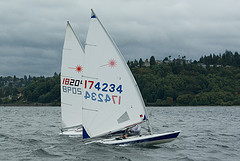Calendar
Results
Go Fast
Local Knowlege
See Also
Random Practice Model

Set up two marks that allow for about 15 seconds of sailing on each upwind tack. The distance between marks will vary depending on wind strength. Practicing this course with several boats will allow simulation of most events where position changes happen in actual racing.
The optimum benefit from this practice model comes when two boats chase one another. Ideally, the weaker sailor is positioned just ahead of the stronger sailor. The boat in the lead must do everything perfect to stay in the lead, because the stronger sailor should capitalize on every mistake. The end result is both sailors have to step up their game. Once the stronger sailor gets ahead, he immediately slows and gets behind and the process repeats till passing is not possible. Suggestion: It is best to set the cunningham, outhaul, and boom vang for a mid range setting and use only the tiller and mainsheet. The course length should be short enough so making adjustments should not be critical. See notes below for each position shown in sketch.
The Steps
- Execute jibe and rounding all as one move. Maximize efficiency of feet, hands, and body motion. Focus your eyes on the mark. Use minimal rudder, steer by heeling. If sail trim is not perfect, err on the side of too loose as you turn.
- Enter wide and exit tight. Position body fore & aft for upwind. Sheet sail in fast, and don’t let boat heel over.
- Sheet in, hike out, accelerate. Don’t allow boats behind you to get on your hip and block you from tacking.
- Straight line speed focus (15 seconds)
- Layline call. Memorize the angle your head must turn to see the mark.
- While tacking, keep eyes focused upwind. Roll as necessary to steer.
- Hike early, accelerate, and keep everything smooth as silk.
- Check mainsheet for knots.
- Enter tight exit wide to bleed speed and stay out of the wind shadow of boats behind you. Steer by heeling rather than rudder.
- Accelerate. Boat behind begins attack to obtain inside overlap.
- Straight line speed focus.
- Set up for rounding. Establish distance needed for “enter wide & exit tight”.